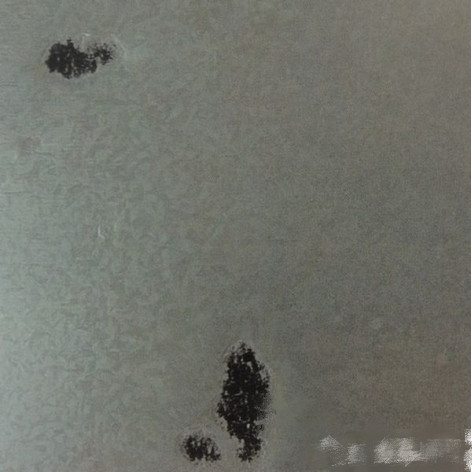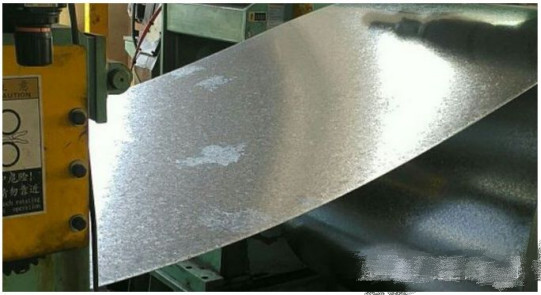Hot-dip galvanizing is one of the effective methods to improve the atmospheric corrosion resistance of steel because of its excellent coating performance and long service life.
There are many common quality defects on the surface of the hot-dip galvanized steel coil layer, such as missing plating, striped feather white pattern, over-thick coating, roughness, grayness, tear streaks, tortoise cracks, crystalline raised lines, “white rust”, etc. The influencing factors more and more difficult to control.
In this regard, we can start from strengthening process control, supplemented by necessary process measures to improve the surface quality of hot-dip galvanizing.
The following is an analysis of the causes and control methods of the surface defects of the hot-dip galvanized coil layer:
1. Surface pretreatment
Poor surface pretreatment is the main reason for leakage plating (exposed iron):
Steel is inevitably stained with paint or mineral grease during delivery, storage, transportation, and processing.
Sometimes the flaw detection surface of welding parts needs to be smeared with special grease that is difficult to clean. Most companies do not have a degreasing process, and only rely on pickling to remove surface impurities. , so that it is easy to cause leakage plating (exposed iron).

The other situation is that the pickling parts are relatively concentrated, densely stacked, heavy and other factors during the pickling process, resulting in under-pickling and wire clipping, or due to the high concentration of pickling, the acid is precipitated on the surface and between the grooves.
In the process, if it is not washed with water or is not washed thoroughly, it is easy to cause leakage plating and virtual plating.
In addition, due to the aging and failure of the solvent, and the workpiece is not placed in time during the drying process, or when the drying time is too long, the surface of the steel is subject to secondary micro-oxidation and the formation of acidic iron salts covering the surface.
It is prone to leakage plating, especially in climates with high relative humidity and foggy weather. This situation is often easily overlooked.
In addition, when solvent hot-dip galvanizing is used, when the most commonly used ZnCl2 and NH4Cl mixed aqueous solution is not in the correct ratio, no eutectic point is formed, especially when the concentration is too high, in the circular hole of the welding corner of the support plate It is very easy to cause ash leakage plating.
2. The thickness of the galvanized steel coil layer is not enough
If the thickness of the galvanized steel coil layer does not meet the standard requirements, it will directly affect the service life of the product. The reasons for the insufficient thickness of the galvanized layer are as follows:
(1) The influence of zinc liquid temperature. When the temperature of the zinc liquid is lower than 430 °C, the diffusion rate of zinc and iron is low, and it is difficult to generate enough iron-zinc alloy layer, and the entire coating is thin; when the temperature is below 460 °C, the zinc layer thickens, and when the temperature continues to rise, the zinc liquid Thinning, the zinc layer thins again.
Therefore, the temperature of molten zinc must be strictly controlled to ensure the stability of strip quality.
(2) The influence of the residence time of the strip in the zinc solution. There is a certain time range for the residence time of the strip in the zinc solution. Determined according to the thickness of the strip, with the extension of the galvanizing time, the thickness of the coating will increase, but excessively extending the galvanizing time will make the zinc layer brittle, which will affect the quality.
(3)The influence of the extraction method of galvanized parts from zinc liquid. When the galvanized parts are drawn out from the zinc liquid, they should be drawn out vertically, and the zinc layer will be thin when the strip is drawn out obliquely. Therefore, when the strip is drawn out of the zinc pot, it should be kept vertically drawn out.
3. Other components in zinc solution
Too many other metal components or harmful elements are mixed in the zinc liquid, which may cause defects such as zinc slag particles adhering to the surface of the coating and some abnormal patterns, cracks and other defects:
(1) Iron
After hot-dip galvanizing for a period of time, zinc accumulation and tiny slag particles will appear on the surface of steel parts, resulting in a rough surface of the coating and a decrease in smoothness. Such tiny particles are generally Fe-Zn alloy particle slag.
When galvanizing at 450 °C, the saturated solubility of iron in the zinc solution is 0.02%. When the iron content in the zinc solution exceeds this value, the ζ and δ1 phases will precipitate to form zinc slag, because the density of this granular slag is not much different from that of zinc.
It gathers and sinks very slowly, and the alloy slag suspended in the zinc liquid will be taken out by the workpiece in the zinc liquid and embedded in the coating, thus affecting the surface quality of the zinc coating.
The sources of iron in the zinc liquid generally include the corrosion of the zinc pot, the dissolution of the parts, the iron ions in the flux and the iron salts on the parts.
Therefore, in order to obtain a smooth and smooth coating, it is necessary to strictly control the iron content in the zinc solution, reduce the introduction of iron ions, control the temperature of the zinc solution, avoid the sudden high and low temperature of the zinc solution, and reduce the corrosion rate of the zinc pot. Generally, when the iron content in the zinc liquid should be 0.20%, the temperature must be cooled and the zinc slag must be salvaged.
(2) Aluminum
Aluminum is the most commonly used additive element in hot-dip galvanizing. Different concentrations of aluminum can be added to the zinc solution to obtain galvanized layers with different properties.
It is generally believed that adding less than 1% (mass fraction, the same below) aluminum to the zinc solution during hot-dip galvanizing can play the following roles: ①improve the brightness of the coating; ②reduce the oxidation of the zinc liquid surface; ③inhibit the brittle Fe—Zn Phase formation to obtain a coating with good adhesion.
In actual production, the zinc liquid containing 0.005% to 0.020% Al can achieve the purpose of bright coating, and can reduce the oxidation of the zinc liquid surface and the generation of zinc ash.
It must be pointed out that the way of adding aluminum should adopt the way of adding Zn—Al master alloy. Often due to the quality of the added master alloy and the improper or too fast method of adding aluminum and zinc-aluminum alloys, a large amount of aluminum and iron compounds are formed in the zinc liquid. ”
Or the particles are suspended on the surface of the zinc liquid and are very viscous, and it is very easy to adhere to the steel parts, which seriously damages the quality of the coating.
Once this situation is found, the addition of alloys should be stopped immediately, and measures should be taken to purify the zinc solution to reduce the aluminum content. If the situation is not serious, the air cooling time can be appropriately extended to prevent bubbles and wrinkles from appearing on the surface of the coating after rapid water cooling.
(3) Tin, lead
In general, zinc ingots do not contain tin, but only a small amount of lead. In recent years, some zinc alloy suppliers have added tin and lead to the so-called multi-component alloys in order to reduce the galvanizing temperature and obtain a bright white coating.
When this multi-component alloy is added to the zinc liquid, the zinc liquid surface can appear a mirror surface at 430 ° C and can be maintained for 10-20 minutes, but when hot-dip galvanizing steel parts, feather-like spots and small and unsightly appear on the surface of the coating.
Once the addition of tin and lead alloys reaches 0.5%, spangles will appear, zinc ash will increase significantly, and production efficiency will also decline, causing undue losses to the enterprise.
Due to its low melting point and excessively high content of lead and tin, the solidification temperature of the zinc solution will drop rapidly, and it is easy to form coarse crystals and cracks during the cooling process of the galvanized steel coil layer, which will affect the surface smoothness of the zinc layer. Corrosion resistance.
Intergranular corrosion is most sensitive to impurity lead, and the corrosion rate increases with the increase of lead content in the coating. Intergranular corrosion will occur when the lead content reaches 0.02%, and the coating will crack along the grain boundary and lose adhesion.
In severe cases, the surface will appear Soybean-sized air bubbles. Therefore, when we apply zinc-aluminum alloy or multi-component alloy, we must find out the content of lead, tin and aluminum in it, and decide whether to add it in the zinc solution.
(4) Nickel
Nickel in the zinc liquid is added as an alloying element to solve the Sterling phenomenon that occurs due to the presence of silicon in the steel in the hot tungsten plating.
The addition of zinc-nickel alloy to the zinc solution can effectively reduce the diffusion rate of zinc and iron atoms in the ζ phase, so the growth of the thickness of the immersion coating can be controlled.
When the Ni content in the zinc solution is 0.06%, the Ni content can reach 0.8% , after adding Ni, the thickness growth is obviously controlled, so the growth of the thickness of the immersion coating can be effectively controlled, and the flow properties of the zinc solution can be improved.
Therefore, the coating thickness of hot-dip galvanizing using zinc-nickel alloy is more uniform, the surface is brighter, and the spangle is less.
galvanized process
The main problems of the imperfect hot-dip galvanizing process are as follows:
(1) After pickling, without water washing or insufficient water washing, it directly enters the solvent pool to increase the acidity of the solvent and increase the iron ions; In the zinc liquid, alloy slag is formed on the surface of the workpiece during galvanizing;
(2) The solvent is aging, there are many iron ions, and there are many impurities. If it enters the zinc solution together with the strip steel without filtering, the viscosity of the zinc solution will increase, the coating will become thicker and rougher, and the adhesion will be poor;
(3) The workpiece is not dried, and Zn(OH)2 particles will be formed when the solvent is hot-dip galvanized with water, which affects the appearance quality of the product;
(4) The solvent is generally weakly acidic. Without heating or low temperature, the drying time will be prolonged, and the surface of the workpiece will be corroded to form adhered iron salts. When galvanizing, the alloy slag will be attached to the surface of the workpiece, making the surface of the coating rough.
“White rust” is a common defect of the galvanized steel coil layer. The main reason is that the lack of passivation treatment in the galvanizing process, the water left on the strip or the unqualified passivation solution cannot achieve passivation. It is not completely dried, and electrochemical corrosion occurs when stored in a humid and poorly ventilated environment, resulting in “white rust” or gray powdery corrosion deposits, which directly affects the quality of products and projects. This white or gray powdery substance is mainly caused by Basic zinc carbonate and other compounds.
In short, the surface defects of strip steel after hot-dip galvanizing are more complicated, and there are many reasons. There are many solutions, and a lot of difficult and meticulous work needs to be done to improve the hot-dip galvanizing technology.
